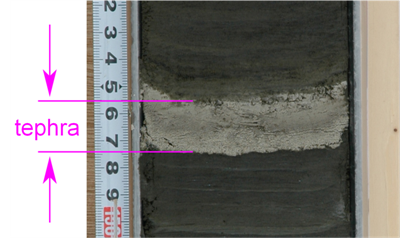Tephra
 The word ‘tephra’ comes from the Greek ‘τέφρα’, meaning ‘ashes’, and describes the fragments of molten rock that are blasted into the air by volcanic eruptions. Depending on the eruption characteristics, tephra may be borne over very large distances from the source volcano, with the distribution of distal tephra deposition significantly influenced by atmospheric circulation patterns (i.e. wind).
The word ‘tephra’ comes from the Greek ‘τέφρα’, meaning ‘ashes’, and describes the fragments of molten rock that are blasted into the air by volcanic eruptions. Depending on the eruption characteristics, tephra may be borne over very large distances from the source volcano, with the distribution of distal tephra deposition significantly influenced by atmospheric circulation patterns (i.e. wind).
Since volcanic eruptions occur over relatively short periods of time, 'tephro-correlation' (the identification of tephra layers at different locations originating from the same eruption event), can be used to provide isochronous markers (time-equivalent tie-points) between geographically-distant sites.
As well as providing correlation between distal sites, tephra layers can also be linked back to proximal deposits from the source volcano. This is important because certain proximal volcanic deposits (i.e. those rich in the mineral, sanidine) can be independently dated by the 'argon/argon (40Ar/39Ar)' method. Therefore, tephra can be used as a direct dating tool, in certain instances, as well as simply being a correlation tool..
The Lake Suigetsu sediment profile contains numerous tephra layers, sourced from explosive volcanic eruptions from along the length of the Japanese archipelago, as well as several tephras originating from Korea. A total of 30 visible tephra layers are present within the SG06 sediment core, but there are likely to be many more 'microtephra' horizons present in addition to these (i.e. layers not visible to the naked eye, but identified through microscopic analysis).
Preliminary tephra analysis of SG06 is being undertaken at the Research Laboratory for Archaeology and the History of Art (RLAHA), University of Oxford and at the Department of Geography, Royal Holloway, University of London.
It is hoped that future 40Ar/39Ar dating of specific sanidine-bearing volcanic deposits correlated to tephra layers within the SG06 core will provide absolute age information, giving independent verification for the primary SG06 varve count chronology, and also facilitating reduction of the cumulative varve counting uncertainties inherent in any such layer counting technique. Furthermore, 40Ar/39Ar ages of tephra layers below the varved portion of the core will provide chronological information for the palaeoenvironmental data from the lower section of the sediment profile.
Publications
The first tephra-based article stemming from the "Suigetsu Varves 2006" project was published by Smith et al. (2011) entitled, "Toward establishing precise 40Ar/39Ar chronologies for Late Pleistocene palaeoclimate archives: an example from the Lake Suigetsu (Japan) sedimentary record". This paper, focussing on a visible tephra layer within SG06 (the "SG06-1288" tephra), geochemically linked this distal deposit to proximal volcanic material from the "U4" unit of Ulleungdo stratovolcano, South Korea (≈500 km west-north-west of Lake Suigetsu). Additionally, these authors performed 40Ar/39Ar dating of these proximal volcanic deposits, demonstrating reliable application of the method at the younger end of the 40Ar/39Ar technique.
Smith et al. (2013) have published a second paper entitled, "Identification and correlation of visible tephras in the Lake Suigetsu SG06 sedimentary archive, Japan: chronostratigraphic markers for synchronising of east Asian/west Pacific palaeoclimatic records across the last 150 ka". This paper describes and characterises the 30 visible tephra layers recorded within the SG06 core and, for the younger tephras (i.e. <52,800 years ago), provides precise age constraints for them.
 The word ‘tephra’ comes from the Greek ‘τέφρα’, meaning ‘ashes’, and describes the fragments of molten rock that are blasted into the air by volcanic eruptions. Depending on the eruption characteristics, tephra may be borne over very large distances from the source volcano, with the distribution of distal tephra deposition significantly influenced by atmospheric circulation patterns (i.e. wind).
The word ‘tephra’ comes from the Greek ‘τέφρα’, meaning ‘ashes’, and describes the fragments of molten rock that are blasted into the air by volcanic eruptions. Depending on the eruption characteristics, tephra may be borne over very large distances from the source volcano, with the distribution of distal tephra deposition significantly influenced by atmospheric circulation patterns (i.e. wind).